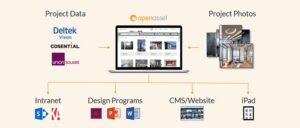How to Calculate and Improve Your RFP Win Rate
Jan 4, 2024

AEC firms spend a lot of time and resources on RFP responses. Unfortunately, the majority of RFP responses sent out today fail to win the project.
However, there are steps you can take to improve the bid-to-win ratio at your firm. But first, you need to learn how to calculate your RFP win rate. In this blog, we’ll provide you with clear steps on how to calculate and improve your RFP win rate.
Understanding the AEC Industry
According to our 2022 AEC Industry Outlook Survey, 42% of AEC professionals anticipate winning new business to be a challenge. If you’re anything like the 500 AEC professionals surveyed, then you’re also struggling with tight deadlines and looking for a different strategy to win more business—and fast.
The results of our AEC industry survey and others tell us that it’s time to start working smarter, not harder. It’s time to focus on winning new projects and more revenue through architecture RFPs.
What Is an RFP Response?
A request for proposals (RFP) is an important document clients use to compare service providers and determine which vendor is the best fit for their project. Upon releasing the RFP, the interested vendor in the project can submit an RFP response (also known as a proposal) for consideration.
As an AEC firm, the trick to increasing your revenue from RFPs is to not only submit a high number of quality proposals each year but to submit a higher number of quality proposals that win the majority of bids.
To ensure quality and a maximum number of winning proposals, the RFP response process is typically managed by an RFP response/proposal writing team. This team is responsible for the firm’s RFP win rate, also known as a bid-to-win ratio or gross proposal win rate.
| TIP: Looking for more ways to ensure your construction proposal maximizes every business opportunity? Get your free Ultimate RFP Checklist now. |
How to Calculate Your RFP Win Rate (Bid-to-Win Ratio)
To fully understand your RFP win rate – and ultimately improve it – you need to implement a process to measure the effectiveness of submitted proposals. Here we explore four of the most common proposal win ratios used by firms today.
1. RFP Win Rate (Bid-to-Win Ratio)
To calculate your firm’s RFP win rate, simply divide the number of bids the firm wins by the number of times your bids were rejected. For example, if your firm wins twenty-five opportunities but loses fifty, your bid-to-win ratio is 50%.
The RFP win rate is the most straightforward of all the proposal win rates you may calculate. The advantage of utilizing this particular win rate is that it provides a single number that you can use to gauge your overall performance between reporting periods or related company divisions.
Though the RFP win rate is a great way to measure your firm’s progress moving forward, it provides little detail or insight into whether your firm is doing well. That’s why the most successful terms also calculate additional proposal win rates that provide insight at a more granular level.
2. Sales Win Rate
Though it often resembles the gross proposal win rate, your firm’s sales win rate accounts for all deal-stage prospects that either did or did not become clients. To calculate your sales win rate, simply divide the number of closed-won deals by the number of all deal-stage prospects.
For example, if in one quarter your firm wins 25 RFPs out of a total of 100 submitted, your win rate is 25% for that period.
3. Incumbent and New Client Proposal Win Rate
Switching service providers and/or onboarding new vendors can be a costly, time-consuming process. There is also a substantial risk that the new vendor will not perform as well as the current vendor.
Thus, when faced with the prospect of onboarding a new vendor or choosing a legacy service provider, most organizations will select the legacy service provider over multiple contract terms. This bias toward legacy vendors is well documented as a type of cognitive bias and enables us to deduce two facts about RFP win rates.
First, incumbent RFP win rates are usually higher than new vendor RFP win rates because the buyer is more reluctant to replace legacy service providers with a new vendor. Second, RFP win rates are likely to vary drastically depending on whether your firm is submitting a proposal as the incumbent or as a new vendor.
Therefore, when calculating RFP win rates, it’s best to clearly distinguish between re-bids to existing clients and new bids to new clients. This means you need to calculate two new win ratios; the proposal win ratio for incumbents and the proposal win ratio for new business opportunities.
Incumbent Proposal (Re-Bid) Win Rate
To determine the incumbent proposal win rate for your firm, simply divide the number of opportunities your firm wins from existing clients by the number of proposals that you submit in total.
New Client Win Rate
To determine your firm’s proposal win ratio for new business opportunities, divide the number of opportunities your firm wins from new clients by the number of proposals that you submit in total.
4. Shortlist Proposal Win Ratio
Though the above-mentioned RFP win rates and bid-to-win ratios are an effective way to measure the success of your proposals, they do not necessarily apply to multi-step RFPs that promote a select number of firms to a final selection process. Among proposal writers and those who respond to RFPs, this type of selection process is called “the shortlist.”
The standard RFP win rate does not apply to short-list RFPs because it only provides insight into one stage of the multi-stage process. By measuring performance at every stage, it’s possible to gain a more precise understanding of where your firm does well and where it can improve.
To calculate the shortlist proposal win ratio for your firm, divide the number of times your firm advances to the shortlist by the number of proposals you submit in response to RFPs. For example, if your firm submits 100 proposals and advances to the shortlist 75 times, your shortlist win ratio is 75%.
How to Improve Your Proposal Win Rate
Now that you have an understanding of RFP win rates, it’s time to start improving them.
Based on a survey of over 1,500 RFP teams, the typical win rate for RFPs across various sectors stands at 44%. Nonetheless, this figure can differ based on the industry and the specific expertise of the company.
Additionally, 17% of teams indicate a success rate of 30-39% for bids, and another 16% achieve a 40-49% win rate for their RFPs. Surprisingly, 8% of teams report winning 80-100% of their proposals.
We’re here to increase your chances of being a part of that 8%. Here’s a list of RFP best practices and techniques to improve the proposal win rate at your firm:
Define Win/Loss Criteria
A prospect may choose to work with your firm for a variety of reasons, but most of the rationale for their selection comes down to:
- Features: The features of your proposal do/do not meet the RFP requirements.
- Price: The prospect does/does not agree to pay the final asking price of your proposal.
- Competition: The incumbent vendor did/did not win the project.
- Need: The perceived value of your product is/is not apparent to the prospect.
- Timing: The prospect has interest but is unable or unwilling to close at the time.
Note that “need” and “timing” can be lumped into a “No Decision” category, as no buying decision was made regarding your firm or a competitor. Some firms choose to include “No Decision” in their win-loss rate metric, meaning if a prospect sees a quote, and ultimately decides not to purchase from you or any of your competitors, that contact would be reflected in your win rate.
Other firms divide wins solely by the number of prospects that made a buying decision – meaning only prospects that decide to go (or stay) with a competitor would count as losses compared to wins.
In these types of situations, the prospect may be in a better place to consider your proposal at a later date. In either case, it’s best to ensure these win/loss criteria are clearly defined so that Sales Ops can understand the reasoning behind the dreaded “Closed-Lost” notification in the CRM.
Depending on your industry, both of the situations mentioned above are possible. Either way, it’s best to have consistency with the types of accounts that are or are not in your win rate calculation.
Track Non-traditional RFP Metrics
Top firms do more than track RFP win rates and revenue, they also track non-revenue related metrics like response speed, individual team member performance, and team sentiment. By switching the focus to process metrics and team performance, these best-in-class firms give themselves an edge over the competition.
Where competitors struggle to manage the RFP creation process, top firms enter into every RFP knowing exactly how much time, labor, and resources it takes to complete an average RFP and use those metrics to balance their workload.
Use Robust RFP Response Tools
The primary reason any firm would allocate resources to calculating and tracking RFP metrics is to create winning response to an RFP and project proposals. However, tracking RFP metrics is only the first step in the process.
If you want to help your AEC firm win more business, then you need to adopt RFP response tools for design, development, and digital asset management. By doing so, you arm your team with the tools they need to take full advantage of the information they learned from tracking RFP metrics.
To win more business, your firm needs a tool that will not only bring order to the RFP process but also enable your team to be more efficient, more productive, and better able to perform their role better than the competition.
OpenAsset is the project-based DAM solution for AEC firms across the world. OpenAsset’s Digital Asset Management platform makes AEC proposals simpler, faster, and more successful. That’s why 99% of customers renew.
Ready to win more business? Schedule a demo.





